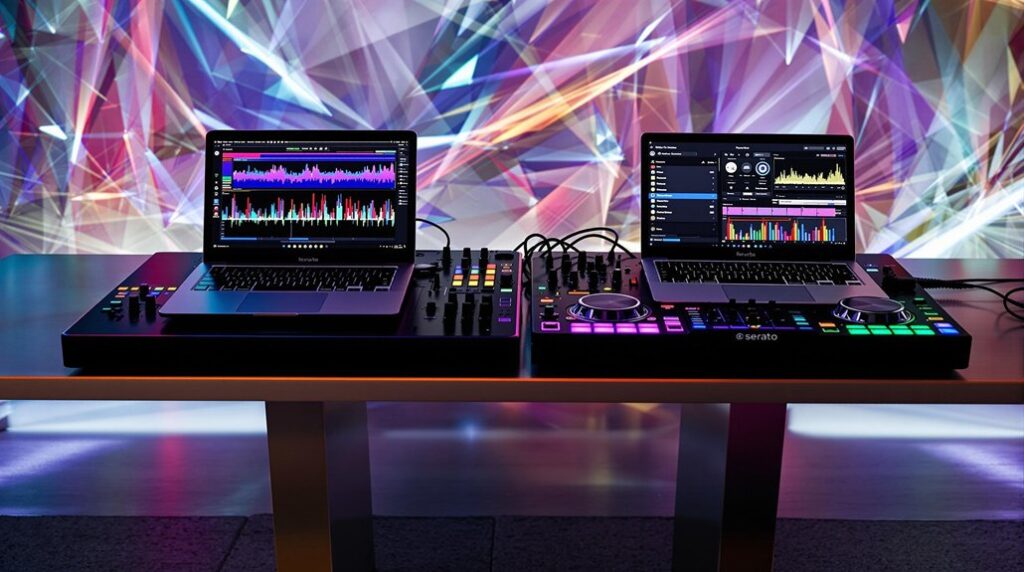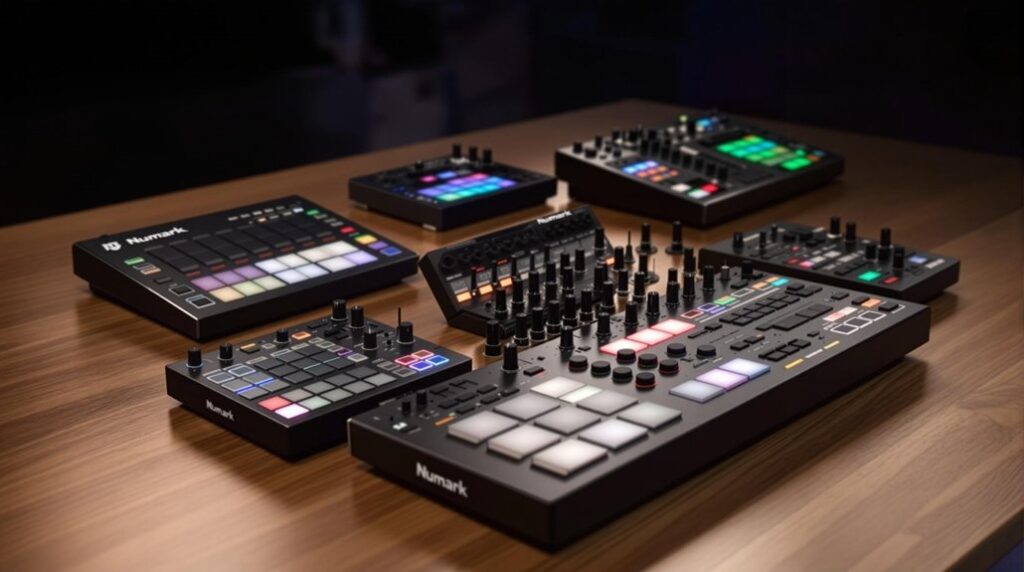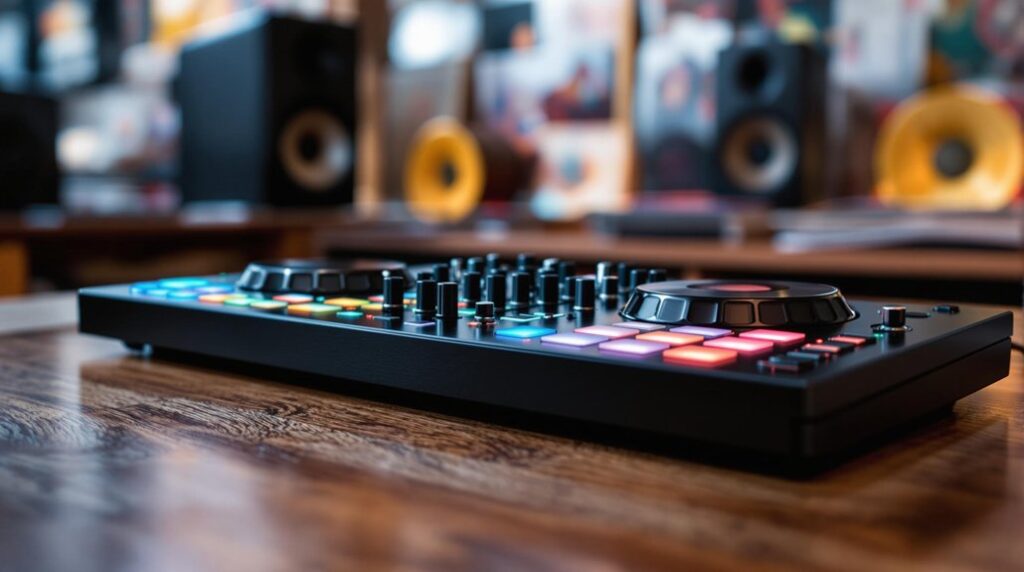Serato Sample allows producers to chop and flip samples effortlessly with a user-friendly interface. It offers random and precise slicing options, ensuring creative freedom and precision. By mapping slices to a keyboard or MIDI controller, one can engage in dynamic sample manipulation. With its time-stretching capability, users can alter pitch without affecting tempo. Advanced pitch shifting and seamless syncing create harmonically rich compositions. Explore these features further to access innovative sampling techniques.
Key Takeaways
- Use the random or fine slicer options in Serato Sample for spontaneous or precise sample chopping.
- Map chopped samples to a keyboard or MIDI controller for dynamic live performance integration.
- Adjust chop lengths using on-screen cursors for tailored sample adaptation.
- Employ time-stretching to maintain pitch integrity while altering tempos.
- Save favorite samples in Serato Sample to streamline creative workflow and enhance productivity.
Exploring Serato Sample Features
Serato Sample offers a multitude of features that seamlessly blend technical precision with creative freedom, making it an essential tool for music producers and sound designers.
Its user-friendly interface enables effortless sample chopping, providing options to slice samples randomly or with meticulous precision to suit user preferences. To understand what's going on under the hood, users can leverage the intuitive mapping of chops to a computer keyboard or MIDI controller, ensuring a fluid and dynamic workflow.
The time-stretching capability allows modification of samples without pitch alteration, enhancing sound design flexibility. Additionally, users can make sure to save their favorite samples directly within the interface, ensuring quick access for future projects, streamlining the creative process while fostering innovation and efficiency.
Serato Sample's integration with Serato DJ Pro offers enhanced performance reliability, allowing users to seamlessly incorporate their chopped samples into live sets without any glitches.
Syncing Samples to Project Tempo
Effortlessly integrating samples into a cohesive musical piece, the process of syncing samples to the project tempo in Serato Sample transforms the producer's workflow.
This automation guarantees samples align seamlessly with the beat, enhancing project integration and creative fluidity. The sample tempo naturally conforms to the project's overarching rhythm, eliminating manual adjustments.
Users have the autonomy to uncheck sync options, should they desire the sample to preserve its original tempo, facilitating unique auditory textures. Real-time tempo adjustments provide further creative latitude, enabling dynamic changes that affect sample playback speed instantly.
This user-friendly interface supports swift experimentation with diverse rhythmic vibes, offering producers a versatile canvas for sonic exploration while maintaining temporal precision in their compositions.
Pitch Adjustment Techniques
Mastering the art of pitch adjustment within Serato Sample opens a gateway to transformative sound design, empowering producers to sculpt samples with precision and creativity.
Through advanced pitch shifting techniques, users can seamlessly alter the pitch of samples without altering their tempo, allowing for innovative soundscapes and creative harmonization strategies.
The intuitive interface facilitates quick modifications, providing visual feedback to guarantee each sample aligns harmoniously within the mix.
By employing unique sample modulation methods, producers can introduce distinct variations, enriching the composition's depth and intrigue.
Effortless pitch shifting without tempo alteration.
Precision pitch control via user-friendly interface.
Enhanced creative harmonization within compositions.
Visual interface feedback for intuitive adjustments.
Endless possibilities for sample modulation and variation.
Incorporating advanced key detection ensures harmonically matched mixes, enhancing the overall quality and creativity of the compositions.
Such techniques enhance the artistry of music production, revealing new creative dimensions.
Slicing Options for Sample Manipulation
When diving into the sphere of sample manipulation, Serato Sample's slicing options provide producers with dynamic tools for crafting unique auditory experiences.
The software offers two primary methods: random slicer techniques and fine slicer advantages. The random slicer delivers unpredictable, serendipitous results, ideal for those seeking spontaneous creative sample arrangements. In contrast, the fine slicer allows for meticulous selection, offering precision and control over each chop.
Users can adjust chop lengths with on-screen cursors, enhancing flexibility. This precision is complemented by the time-stretching feature, which maintains pitch integrity across varying tempos. Such capabilities enable producers to weave intricate sonic textures, fostering imaginative soundscapes.
Additionally, the streamlined system for saving favorite samples guarantees efficient workflow continuity in future projects. Producers can also benefit from critical listening techniques to ensure rhythm and harmony are consistent when manipulating samples.
Mapping Chops to Keyboard and MIDI
Building upon the versatile slicing options, Serato Sample introduces an advanced method for integrating chopped samples into live performances and production workflows: mapping chops to a keyboard or MIDI controller.
This feature transforms the creative environment, allowing users to trigger samples with precision and flair. The intuitive interface facilitates seamless assignment of slices to keys or pads, enhancing dynamic sampling capabilities.
By utilizing keyboard shortcuts and MIDI controller setup, producers can intuitively control sample playback, fostering an atmosphere ripe for innovation and expression.
- Tailor individual chop lengths using cursors for custom sample adaptation.
- Utilize random slicer for spontaneous creativity or fine sample option for meticulous control.
- Assign samples to specific keys or pads for personalized playability.
- Implement performance tips for dynamic live manipulation.
- Enhance beat-making with intuitive mapping techniques.
Incorporating fader techniques can further enhance live performances, enabling fluid transitions and engaging audience interaction while manipulating samples on the fly.
Time-Stretching for Unique Sound Design
Time-stretching in Serato Sample transforms sound design into an exploratory art form, empowering producers to manipulate tempo without altering pitch and maintain the musical integrity of their projects. By accessing time-stretching techniques through an intuitive user interface, producers can seamlessly adapt sample lengths to fit desired beats. This capability is instrumental in crafting creative soundscapes, allowing for the metamorphosis of ordinary audio into innovative musical elements.
| Feature | Benefit | Result |
|---|---|---|
| Time-Stretching | Tempo adjustment without pitch | Maintained musicality |
| Rhythmic Variations | Enhanced texture | Unique sound design |
| Normalization | Prevents clicks and pops | Higher audio quality |
These rhythmic variations are pivotal in achieving unique textures, providing an avenue for imaginative expression in sound manipulation.
Recording Notes and Automations
Recording notes and automations in Serato Sample enhances the production process to a new level of dynamic creativity.
By utilizing advanced recording techniques, producers can capture authentic performances directly from a MIDI controller or computer keyboard. Automation tips include adjusting parameters in real-time during performance capture, allowing for simultaneous note and automation recording. This integration enriches the sonic environment and provides a more nuanced and expressive sound.
Post-recording, producers can mute the original MIDI track to concentrate on the newly recorded layers, ensuring clarity. Normalizing audio prevents unwanted artifacts like clicks and pops. Experimenting with pitch adjustments further diversifies melodic lines.
- Enable recording for seamless note capture.
- Adjust parameters live for dynamic automation.
- Mute original tracks for focused editing.
- Normalize recordings for clean playback.
- Explore pitch shifts for creative sound design.
Resampling for Enhanced Creativity
In the realm of digital music production, resampling within Serato Sample stands as a powerful tool for elevating creative potential. By employing creative resampling techniques, producers can transform newly crafted melodies or beats into canvases for sound design exploration.
The normalization feature guarantees balanced audio levels, mitigating unwanted artifacts like clicks and pops. As users engage in unique audio manipulation, recording notes and automating parameters offer dynamic alterations, breathing life into resampled audio.
The ability to mute the original MIDI track allows for focused attention on clarity within the mix. Additionally, distinct pitch adjustments enable producers to reshape resampled sounds, infusing tracks with fresh melodies and distinctive vibes, thereby amplifying the creative possibilities inherent in the music-making process.
Building a Complete Beat With Samples
In crafting a complete beat with samples, the producer begins by layering percussive elements such as loops, kicks, snares, and claps to construct a robust rhythmic framework.
Precision in timing is essential; adjusting claps manually and strategically placing kicks can infuse the composition with dynamic swing and groove.
The process culminates in a cohesive arrangement by integrating bass elements, which complement the percussion and enhance the sonic architecture of the beat.
Layering Percussive Elements
Crafting a compelling beat in Serato Sample often begins with the meticulous layering of percussive elements, a process that establishes the rhythmic core of the track.
Kick layering techniques are pivotal in creating a robust foundation; precise manual placement introduces swing, enhancing the beat's dynamic quality. Snare placement strategies, including deliberate timing adjustments, guarantee a natural groove, while maximizing the kick's volume ensures a punchy mix presence.
- Utilize kick layering techniques to achieve a solid rhythm base.
- Adjust snare timing for natural groove and delay compensation.
- Introduce swing through manual kick placements for dynamic beats.
- Prioritize kick volume to guarantee a punchy, mix-cutting backbone.
- Enrich the beat's structure by adding bass elements post-percussion layering.
This approach effectively sets the stage for further musical exploration.
Enhancing Groove Dynamics
Orchestrating groove dynamics in a complete beat necessitates a nuanced interplay of rhythmic elements, where percussive loops, kicks, snares, and claps converge to form a rich sonic tapestry. Groove enhancement techniques involve strategic layering, guaranteeing percussive loops complement the potent strikes of kicks and the crisp resonance of claps. Applying swing rhythm tips, producers manually adjust the timing of claps and kicks, introducing a fluid, humanized rhythm. Dynamic layering strategies guarantee each element occupies its sonic space, maximizing the kick drum's volume to cut through the mix effectively. Bass elements, added post-structure, anchor the groove, binding the samples into a cohesive unit.
| Element | Technique | Result |
|---|---|---|
| Percussion Loops | Layering | Fuller sound texture |
| Claps | Timing adjustments | Enhanced groove dynamics |
| Kicks | Manual placement | Humanized swing effect |
Frequently Asked Questions
How to Chop Samples in Serato Sample?
In exploring sample selection techniques, one efficiently navigates Serato Sample's editing workflow. Creative chopping methods involve using random slicers for innovation or precise slicing for accuracy. Users manipulate chop lengths and employ time-stretching for unique auditory textures.
How Do You Cut Songs on Serato?
When cutting songs, users employ sample selection techniques, utilizing editing precision tips to refine audio segments. Creative slicing methods enable dynamic composition, integrating waveform analysis and tool manipulation for tailored cuts, enhancing overall musical expression and production efficiency.
How Do You Loop a Serato Sample?
In exploring looping techniques, one enhances sample manipulation by selecting slices and engaging the loop function. Adjusting loop length and employing time-stretching enriches the creative workflow, allowing seamless integration and synchronization with project tempo for dynamic soundscapes.
How Do You Split Stems in Serato?
To achieve effective stem separation techniques, one can employ precise audio editing tips, utilizing slicing options for sample manipulation tricks. This process involves isolating sections of audio, assigning them to controllers, and applying time-stretching for seamless integration.
Conclusion
In exploring Serato Sample's robust toolkit, producers access a domain of sonic possibilities. By syncing samples to project tempo and utilizing advanced pitch adjustment techniques, they achieve seamless integration. The slicing options offer intricate sample manipulation, while mapping chops to keyboards and MIDI controllers enhances musical expression. Time-stretching fosters unique sound design, and recording notes and automations enriches creative workflows. Resampling becomes a catalyst for innovation, culminating in a complete beat that exemplifies the artistry of modern music production.




